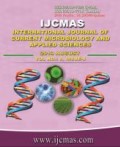


 National Academy of Agricultural Sciences (NAAS)
National Academy of Agricultural Sciences (NAAS)

|
PRINT ISSN : 2319-7692
Online ISSN : 2319-7706 Issues : 12 per year Publisher : Excellent Publishers Email : editorijcmas@gmail.com / submit@ijcmas.com Editor-in-chief: Dr.M.Prakash Index Copernicus ICV 2018: 95.39 NAAS RATING 2020: 5.38 |
Buckeye rot caused by Phytophthora nicotianae var. parasitica (dastur) Waterhouse is the serious menace to the cultivation of tomato in Himachal Pradesh. Seventeen isolates of Phytophthora nicotianae var. parasiitca causing buckeye rot were collected from different districts of Himachal Pradesh. Sensitivity of these isolates to three commonly used fungicides i.e. mancozeb 75WP (Indofil M-45), copper-oxychloride 50WP (Blitox-50) & metalaxyl-M 4%+ mancozeb 64%WP (Ridomil Gold) in Himachal Pradesh was examined by dual culture technique. On the basis of sensitivity to fungicides the 17 isolates were categorized into three sensitivity classes i.e. highly sensitive, moderately sensitive and less sensitive isolates. Out of seventeen isolates, nine isolates were highly sensitive (Pn-3, Pn-4, Pn-5, Pn-7, Pn-9, Pn-10, Pn-12, Pn-14 & Pn-17), seven isolates (Pn-1, Pn-2, Pn-6, Pn-8, Pn-11, Pn-15 & Pn-16) were moderately sensitive and one isolate (Pn-13) was found less sensitive to mancozeb 75WP. Sensitivity to copper-oxychloride 50WP revealed that seven isolates (Pn-2, Pn-3, Pn-9, Pn-10, Pn-11, Pn-13 & Pn-16) were highly sensitive, nine isolates (Pn-1, Pn-4, Pn-5, Pn-7, Pn-8, Pn-12, Pn-14, Pn-15 & Pn-17) were moderately sensitive and one isolate (Pn-6) was found less sensitive to copper-oxychloride. Whereas, eleven isolates (Pn-2, Pn-3, Pn-4, Pn-5, Pn-6, Pn-10, Pn-11, Pn-12, Pn-13, Pn-15 & Pn-17) were highly sensitive, five isolates were moderately sensitive (Pn-1, Pn-7, Pn-9, Pn-14 & Pn-16) and only one isolate (Pn-8) was found less sensitive to metalaxyl-M 4%+ mancozeb 64%WP. All the isolates were found sensitive to commonly used fungicides but, degree of sensitivity varied significantly. None of the isolate was found resistant to any of the three fungicides i.e. mancozeb 75WP, copper-oxychloride 50WP and metalaxyl-M 4%+ mancozeb 64%WP in Himachal Pradesh.
 |
 |
 |
 |
 |